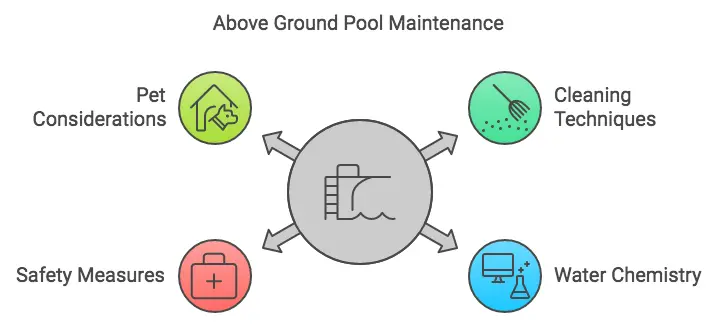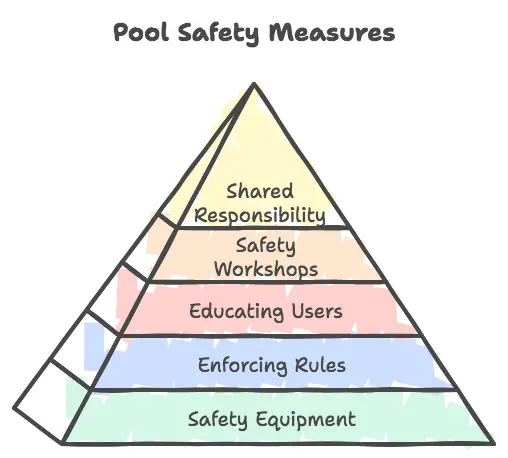CALL US NOW!
+91-213-666-0027
CALL US NOW!
+91-213-666-0027
Above Ground Pool Maintenance and Safety Guide 2024
- Home
- Above Ground Pool Maintenance and Safety Guide 2024

Owning an above ground pool can be a wonderful experience. It’s like having a mini oasis right in your backyard. But with great leisure comes the responsibility of pool care. Whether you’re a new pool owner or a seasoned DIY enthusiast, understanding Pool Maintenance and Safety to properly maintain your above ground pool is crucial. This guide will walk you through everything you need to know—from regular cleaning routines to ensuring safety around your pool.

The Importance of Pool Maintenance
Keeping your above ground pool well-maintained ensures a clean and safe swimming environment. Regular maintenance not only extends the life of your pool but also saves money by preventing costly repairs. For DIY enthusiasts and homeowners, mastering pool maintenance means enjoying a sparkling clean pool all season long without the added expense of professional services.
When it comes to pool maintenance, consistency is key. Establishing a routine will help keep your water crystal clear and safe for swimmers. This guide provides all the essential tips and tricks to efficiently maintain your above ground pool, focusing on practical, easy-to-follow advice.
We will cover everything from regular cleaning techniques to adjusting water chemistry, along with safety measures and pet considerations. Let’s dive into the practical tips that will transform your pool care routine.
Table of Contents
Practical Tips for Maintaining Your Above Ground Pool
Regular Cleaning
Regular cleaning is the foundation of maintaining an above ground pool. It helps prevent algae buildup and keeps the water invitingly clear. Begin by skimming debris off the surface. Leaves, insects, and other debris can quickly accumulate, making the water look unappealing.
After skimming, vacuum the pool floor. This step removes dirt and debris that settle at the bottom. Opt for a reliable pool vacuum cleaner to make this process more efficient. Regular vacuuming prevents the growth of algae and bacteria, keeping your pool safe for everyone.
Don’t forget to brush the walls and floor of your pool. This step helps dislodge any dirt or algae that might be clinging to surfaces. Regular brushing maintains a clean pool and reduces the chances of slippery surfaces or stubborn stains.
Water Chemistry
Maintaining balanced water chemistry is essential for safe swimming. Start by regularly testing pH levels. A pH level between 7.2 and 7.8 is ideal. It ensures the water is neither too acidic nor too alkaline, preventing skin and eye irritation.
Adjust chlorine and alkalinity levels as needed. Chlorine keeps the water sanitized, preventing harmful bacteria and algae growth. Alkalinity acts as a pH buffer, ensuring it remains stable. Check these levels at least once a week to ensure optimal water quality.
It’s also important to shock your pool occasionally. Shocking involves adding a large dose of chlorine to eliminate contaminants. This deep-cleaning process helps clear cloudy water and kills bacteria, keeping your pool fresh and inviting.
Equipment Maintenance
Proper equipment maintenance is vital for a functional pool. Begin by checking filters and pumps regularly. Clean or replace filters as needed to ensure they efficiently trap dirt and debris. A clean filter prolongs the life of your pump and enhances its performance.
Clean the skimmer baskets frequently. Skimmers help remove debris from the water’s surface, preventing clogs and maintaining circulation. Empty and clean the baskets to ensure they function effectively, keeping your pool clean and well-circulated.
Inspect other pool equipment, such as ladders and rails, for any signs of damage or wear. Ensure these components are secure and functional, reducing the risk of accidents or injuries. Regular inspections help maintain a safe swimming environment.
Ensuring Safety Around Your Pool
Pool Safety Measures
Implementing pool safety measures is crucial for preventing accidents. Start by emphasizing the importance of safety equipment, like life rings and pool alarms. Ensure these tools are easily accessible and regularly maintained.
Establish and enforce safety rules for all pool users. Set guidelines for safe swimming practices, including proper attire and no running around the pool. Educating users, especially children, about pool safety can significantly reduce accident risks.

Consider hosting a pool safety workshop or refresher course for family and friends. This can be an engaging way to reinforce safety practices and ensure everyone is knowledgeable about emergency procedures. Safety is a shared responsibility—make sure everyone is on board.
Fencing for Above Ground Swimming Pools
A fence around your pool area enhances safety and privacy. Explore different types of fencing options, such as wood, vinyl, or metal. Choose a style that complements your backyard aesthetics while providing robust security.
Follow guidelines for fence installation and maintenance. Ensure the fence is tall enough to prevent unauthorized access, especially by children or pets. Regularly inspect the fence for any damage or weaknesses, and repair them promptly.
Consider adding a self-latching gate to your pool fence. This feature adds an extra layer of security, ensuring that the gate closes automatically after use. It’s a simple yet effective way to enhance pool safety, especially in households with young children.
Choosing the Right Covers for Protection
Types of Pool Covers
Choosing the right pool cover provides protection and convenience. Explore different types of covers, such as safety covers and winter covers. Safety covers prevent accidental falls into the pool, while winter covers protect it during the offseason.
Each type of pool cover has its pros and cons. Safety covers are ideal for year-round use, offering protection against debris and enhancing safety. However, they can be expensive. Winter covers are more affordable but require proper installation and removal.
Consider your specific needs when selecting a pool cover. If safety is a top priority, invest in a high-quality safety cover. If you seek protection during specific seasons, a winter cover might suffice. Assess your budget and requirements to make an informed choice.
Benefits of Using Pool Covers
Using pool covers offers several benefits. First, they reduce maintenance effort. Covers prevent debris from entering the pool, minimizing cleaning tasks and the need for chemical adjustments.
Pool covers also enhance safety for pets and children. They provide a barrier, preventing access to the water when the pool is not in use. This added layer of protection is especially important for households with young children or pets.
Additionally, covers help retain heat, reducing energy costs associated with heating the pool. They also minimize water evaporation, conserving water and lowering the frequency of refills. Overall, pool covers are a worthwhile investment for any pool owner.
Keeping Pets Safe in Pools
Can Dogs Swim in Above Ground Pools?
Wondering if dogs can swim in above ground pools? Yes, they can, but certain safety considerations are necessary. Ensure your dog is comfortable with water and knows how to exit the pool safely.
Provide a designated entry and exit point for your dog. A ramp or set of steps makes it easier for them to enter and leave the pool. Never leave your dog unattended while swimming, and supervise their activities closely.
Be mindful of your dog’s comfort and health. Not all dog breeds are strong swimmers, so consider using a doggie life jacket for added safety. Always rinse your dog after swimming to remove chlorine or other pool chemicals from their fur.
Tips for Pet Owners
If you have pets, it’s essential to supervise them while swimming. Keep a watchful eye on your furry friends to ensure they enjoy the pool safely. Supervision prevents potential accidents and mishaps.
Provide safe exit points for your pets. Having multiple exit options reduces the risk of panic or accidents if they struggle to find their way out. Install ramps or steps at different locations around the pool.
Regularly check your pool’s water chemistry to ensure it’s safe for pets. Chemicals may irritate sensitive skin or eyes, so maintain balanced water conditions. Consult your veterinarian for any specific concerns related to your pet’s health.
Seasonal Pool Maintenance
Preparing for Summer
Preparing your pool for summer involves several key tasks. Start with pre-season cleaning tasks. Remove winter covers, clean debris, and inspect your pool for any signs of damage during the offseason.
Adjust water balance to ensure a safe swimming environment. Test and adjust pH, chlorine, and alkalinity levels. This step helps prevent water clarity issues and keeps swimmers comfortable.
Give your pool equipment a thorough inspection. Check filters, pumps, and other components for functionality. Address any issues promptly to avoid disruptions during the swimming season.
Winterizing Your Pool
Winterizing your pool is crucial for protecting it during the offseason. Begin by thoroughly cleaning the pool and balancing water chemistry. This step prevents algae growth and keeps your pool ready for next season.
Remove and store pool accessories, such as ladders and floats. These items can be damaged by harsh winter conditions, so it’s best to keep them safe indoors.
Maintain your pool equipment during winter. Regularly check pumps and filters to ensure they remain in good condition. Proper winterization extends the life of your pool and minimizes repair costs.
Conclusion
Maintaining your above ground pool doesn’t have to be daunting. By following the practical tips and safety measures outlined in this guide, you’ll enjoy a clean, safe, and inviting pool year-round. Remember, regular cleaning, balanced water chemistry, and safety precautions are key to successful pool maintenance.
Encourage regular upkeep and safety practices among your family and friends. A well-maintained pool enhances the enjoyment and value of your home. For further resources and expert advice, consider reaching out to local pool care professionals.
Dive into your pool maintenance routine with confidence and make the most of your above ground oasis. With the right care, your pool will continue to provide endless fun and relaxation for years to come.
Frequently Asked Questions (FAQs)
1. How often should I clean my above ground pool?
For optimal cleanliness, aim to clean your pool at least once a week. This includes skimming the surface for debris, vacuuming the floor, and scrubbing the walls to prevent algae buildup. Regular cleaning helps maintain balanced water chemistry and prolongs the life of your pool.
2. Can I leave my pool up during winter?
While it is possible to leave your above ground pool up during winter, proper winterization is essential to avoid damage. Make sure to follow winterizing steps, such as cleaning, balancing water chemistry, and covering the pool with a winter cover to protect it from harsh weather conditions.
3. How can I prevent algae in my pool?
Preventing algae involves maintaining proper water chemistry and circulation. Keep your chlorine and pH levels balanced, and run your pump and filter regularly. Routine cleaning, including brushing the walls and vacuuming, is crucial to deter algae growth.
4. Is it necessary to use a pool cover?
Using a pool cover is highly recommended, as it offers numerous benefits such as reducing maintenance, conserving heat, preventing evaporation, and enhancing safety for children and pets. It helps keep your pool cleaner and more energy-efficient.
5. What should I do if my pool water is cloudy?
If your pool water is cloudy, check and adjust your chemical levels, especially chlorine and pH. Shock the pool if necessary to clear the water. Examine your filtration system to ensure it’s functioning properly, and run it for longer periods to improve water clarity.
